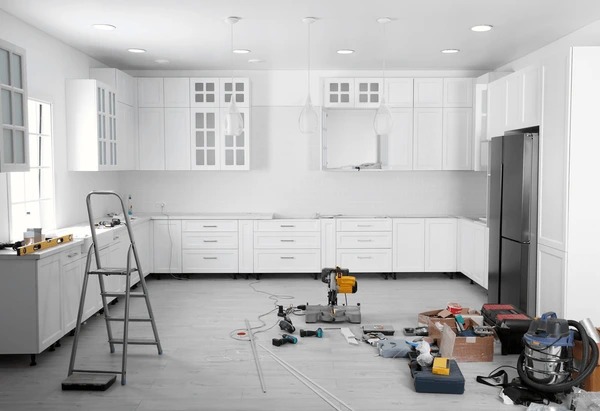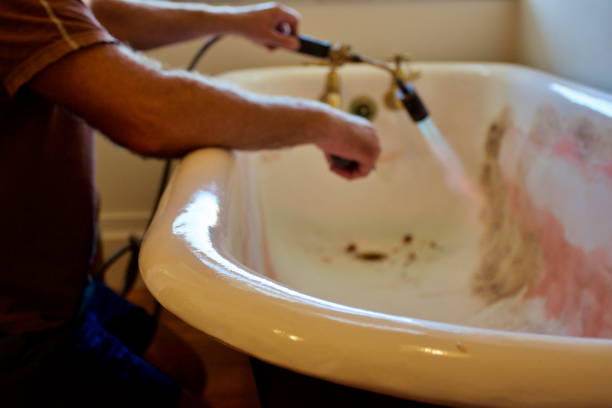Dreaming about shiny counters feels great. However, one question soon arises. How much does it cost to renovate a kitchen? Online estimates vary widely. Therefore, this guide leans on fresh studies from HomeAdvisor, Remodeling Magazine, and Houzz. These reports show what real homeowners pay right now.
However, you will see clear ranges, hidden fees, and smart saving moves. Moreover, short stories keep the math friendly. Every sentence stays simple, so nothing feels heavy. Together, we will follow the dollars from demo day to dinner time. Let’s explore today’s kitchen remodel cost story. (According to HomeAdvisor, JLC, OnlineHouzz)
1. The National Cost Snapshot
To begin with, let’s zoom out and check the big board.
- HomeAdvisor places the average kitchen remodel cost at $26,966, with most jobs landing between $14,589 and $41,530. (HomeAdvisor)
- Next, a newer 2025 HomeAdvisor update shows a full kitchen installation averaging $65,000, with projects spanning $5,000 to $125,000. (HomeAdvisor)
- Meanwhile, Remodeling Magazine’s 2024 Cost vs. Value report lists a mid-range major remodel at $79,982 and an upscale overhaul at a steep $158,530. (JLC Online)
- “Big kitchens eat big dollars; small kitchens chew less, yet surprises can still bite.”
- However, the medians provide a different perspective. Houzz’s 2025 Kitchen Trends Study finds half of homeowners spend around $60,000 on a major redo, while the top ten percent soar past $180,000. (Houzz)
Therefore, square footage, finish level, and layout move to change everything.
Quick facts
- National spending jumped 12 % in two years.
- Labor usually takes 25–35 % of the budget.
- Cabinets claim the single largest slice, about one-third.
Cost tiers at a glance
| Remodel Tier | Typical Spend | What It Includes |
| Cosmetic spruce-up | $5K–$15K | Paint, hardware, lighting |
| Pull-and-replace | $15 K–$40 K | New cabinets, counters, same layout |
| Major remodel | $40K–$90K | Layout tweaks, better appliances |
| Upscale gut | $90K–$150K+ | Walls moved, luxury finishes |
Moreover, geography matters. Coastal cities often contribute 30% of labor, while rural towns may drop below national norms. Likewise, timing plays a role. In winter, bids sometimes dip as contractors hunt for work.
So, where should you start? Industry pros suggest anchoring your target at 10–15 % of current home value, which for a $350,000 house equals $35,000–$52,500. Then, add a 10 % contingency for the rotten pipe you didn’t know about.
Finally, breathe. Because real costs live on a sliding scale, planning early helps you steer each dollar. Furthermore, we will unpack what drives those numbers—and how you can guide them.
2. Size, Scope, and Style: Your Budget Movers
The footprint of a kitchen determines the cost. Homeowners spend $100–$200 per square foot on basic makeovers that keep layouts intact. (As reported by USA Cabinet Store) Yet, mid-range projects step up to $200–$350 per square foot once tile backsplashes, better appliances, and minor wall fixes join in. Upscale redos—think new walls, pro-grade appliances, and high-end finishes—often exceed $450 per square foot in big cities.
“Small kitchens bite, but moving walls make them roar.”
However, size only provides a partial picture. Scope rules next. Meanwhile, moving a sink four feet high demands new supply lines, fresh drains, and patching floors. Knocking down one load-bearing wall adds an engineer’s stamp plus hefty beams. So, each move can increase labor costs by 20 % or more. Every extra hour counts because labor often eats 25–35 percent of the budget.
The style also nudges numbers. A flat-panel stock cabinet costs less than handmade inset wood. Subway tile also runs under $10 per square foot; handmade zellige pushes past $40. Adding a waterfall island edge forces fabricators to buy larger slabs and charge extra for seams.
Quick checkpoints
- Layout changes require plumbers, electricians, and sometimes inspectors.
- Custom details: We require specialized trades and longer lead times.
- Geography: Coastal labor can run 30 percent higher than rural rates.
- Season: Winter bids often drop as contractors fill calendars.
Cost table by kitchen size
| Size | Basic Face-Lift | Mid-Range Pull-and-Replace | Upscale Gut |
| 100 sq. ft. | $10K-$20K | $20K-$35K | $45K-$60K |
| 150 sq. ft. | $15K-$30K | $30K-$50K | $65K-$90K |
| 200 sq. ft. | $20K-$40K | $40K-$70K | $90K-$125K |
Smart sizing tips
- Mark “can’t-live-without” moves first.
- Keep plumbing in place when possible.
- Combine meal prep and seating on one island to shrink cabinetry needs.
Map the scope early because every square foot and wall shift costs money. Then, balance design dreams with real limits before calling builders. This strategy saves time and heartache while protecting your kitchen remodel cost from ballooning.
3. Materials Matter: Cabinets, Counters, and Appliances
Material choices decide where the budget finally lands. Cabinets top the list, grabbing 25–40 percent of total spending.
- Stock boxes start near $150 per linear foot; custom inset cherry can soar beyond $1,200 per foot. Because doors drive much of that price, slab fronts or refacing can keep wallets calm.
- Next come countertops. Laminate still rules the entry tier at $30–$60 per installed foot. The current favorite averages $80–$120 and needs no yearly sealing.
- Marble or soapstone jumps above $150, while ultra-compact sintered slabs test budgets past $200. CountertopSmart says most owners pay about $3,100 in total for counters.
- Mixing surfaces—like butcher block on an island and quartz around the sink—bridges cost and function.
- Flooring follows. Luxury vinyl plank offers water resistance for under $5 per square foot installed. Tile climbs toward $15, and site-finished hardwood averages $18. Add underlayment and leveling in older homes; surprises lurk beneath worn linoleum.
- Appliances swing wide. Big-box bundles start near $3,500 for a stainless set, while pro-style suites shoot past $15,000. Lowe’s and Home Depot list many four-piece packages between $3,300 and $9,100.
Energy Star models may cost more upfront but slice yearly bills—an invisible but steady payback.
Typical cost breakdown
| Component | Share of Budget |
| Cabinets & Hardware | 29 % |
| Installation labor | 17 % |
| Appliances & vents | 14 % |
| Countertops | 10 % |
| Flooring | 7 % |
| Lighting | 5 % |
| Walls & ceilings | 5 % |
| Everything else | 13 % |
“Choose splurges you touch daily—handles, faucets, counters—because those spark joy every meal.”
Cost-Savvy Moves
- Upgrade drawer glides, not cabinet carvings.
- Pick mid-grade quartz and reserve marble for a small baking zone.
- Watch holiday appliance sales for double-digit markdowns.
Finally, remember that finishing work matters. A skilled painter and tight caulk lines also make even modest materials shine. When materials and craftsmanship align, the kitchen renovation feels upscale without costing you every paycheck.
4. Labor, Permits, and Surprises You Can’t Ignore
Often invisible, labor consumes a significant portion of every budget. Skilled labor costs can climb to 40 % of total spending because carpenters, plumbers, and electricians carry high hourly rates.
Moreover, general contractors add management fees, insurance, and markup for every nail. Therefore, each extra workday boosts the final bill.
However, permits matter next. Depending on city rules, a typical kitchen remodel permit ranges from $500 to $1,500. Meanwhile, some larger metro areas charge closer to $1,000 on average. Moreover, always check if your contractor includes these fees; unexpected invoices can be frustrating.
“The wall you open often opens your wallet, too.”
Unseen problems create the loudest groans. Old wiring, hidden water damage, or asbestos tiles can emerge once cabinets leave. Because fixes are mandatory, experts urge a contingency fund of 5–10 % of the total budget. (Multiproject) In volatile markets, aim higher for peace of mind.
Furthermore, plan for waste removal. Renting a 20-yard dumpster averages about $632, yet rates swing from $354 to $1,332. Finally, without a bin, debris piles quickly block progress and safety exits.
Hidden-cost checklist
- Demo time: Extra layers of tile double tear-out hours.
- Structural fixes: A sagging beam demands an engineer.
- Code updates: Older houses often lack GFCI outlets near sinks.
- Utility upgrades: New circuits or larger gas lines add permits and fees.
Four smart safeguards
- Document scope early. Before signing, clearly outline the included items.
- Schedule daily huddles. Schedule a five-minute huddle to quickly identify minor errors.
- Please ensure that change orders are approved in writing. Never rely on hallway chats.
- Release payments by milestone. Retain the final ten percent until the punch list items are completed to a high standard.
Furthermore, keep a binder of receipts, manuals, and inspection stamps. Prospective buyers also love proof of proper work; your insurer may ask for it later.
Since labor, permits, and unexpected expenses are the foundation of kitchen renovation expenses, closely monitoring them can prevent unnecessary stress. Furthermore, we will delve into innovative ideas that maximize every leftover budget without compromising on essential aspects.
5. Budget Stretchers: Smart Ways to Save
Let’s take a different approach and safeguard our finances. To begin with, touch what you own. Painting kitchen cabinets costs only paint and patience, yet it delivers a fresh look for a fraction of the replacement cost. (HGTV)
However, over two weekends, HGTV notes, washing, priming, and painting may bring tired doors back to life. Then go shopping with a calendar. Large-appliance costs plummet, typically by 25% or more, around holiday weekends like Memorial Day or Labor Day, according to consumer reports. (Consumer Reports). Therefore, schedule orders to coincide with sales periods.
Furthermore, mix materials. For instance, choose a sturdy quartz around the sink but use an affordable butcher block on the island. Because butcher block comes unfinished, you can oil it yourself and save on fabrication.
Reuse where possible. Many reuse centers also accept old cabinets and grant tax slips. Meanwhile, selling salvageable items online funds new lighting or drawer organizers.
Money-wise moves
- You can DIY demo and paint your own space. Simple sweat equity trims labor bills fast.
- Keep plumbing put. Every relocated drain requires a plumber.
- Limit custom touches. Open shelves cost less than full uppers.
- Buy remnants. Stone yards offer discounts on small quartz pieces that are perfect for a coffee bar.
- Use pull-out trays sparingly. One high-use cabinet earns the splurge.
“Save on what you can; spend on what you touch daily.”
Furthermore, tap energy rebates. Some utilities reduce net cost over time by allowing cash back for Energy Star fridges or induction stoves. Check local programs before purchasing.
Please number your plan and adhere to it.
- List must-haves. Prioritize safety and functionality above all else.
- Write nice-to-haves. Rank by daily joy factor.
- Set a firm ceiling. Include that 10 % cushion.
- Track every receipt. Small extras snowball fast.
Yet, leave room for one joyful splurge, like a statement pendant. Because morale matters during weeks of dust, that glow feels worth every penny.
By combining timing, sweat effort, and clever material swaps, a kitchen remodeling can also save money without compromising design. The last part will show how well solid preparation and energy-wise smart decisions increase your long-term profit.
6. Payback and Planning: Boosting Return from Day One
Money spent today should still smile tomorrow. The 2024 Cost vs. Value report says a mid-range major kitchen remodel ROI averages around 49 % at resale, while a minor pull-and-replace returns roughly 72 %. (JLC Online) Though numbers shift by region, one lesson stays clear: renovate first for lifestyle, then enjoy the bonus bump in value.
“Fix the bones before chasing the beauty.”
Core investments that protect value
- We ensure the safety of wiring and plumbing. Inspectors spot shortcuts fast.
- Proper ventilation. A quiet, code-rated hood prevents moisture and odor damage.
- Sturdy subflooring. For creep-free floors, please ask both owners and appraisers.
- Energy-smart lighting. LED cans also cut bills and attract eco-minded buyers.
Because buyers lean on home inspection reports, these hidden upgrades often seal the sale.
Energy savings that pay twice
Replacing a 15-year-old fridge with an Energy Star model can save $50–$80 per year in power. Over ten years, that’s $500-plus—enough to fund new faucets. Induction cooktops heat faster and spill less heat, so summer air conditioning runs shorter, trimming more dollars.
Future-proof features
- Wider walkways. Thirty-six-inch clearances welcome strollers and wheelchairs.
- Drawer microwaves. Kids also reach safely; seniors avoid heavy lifts.
- Pull-out trash centers. Hidden bins keep floors tidy and add daily ease.
These elements cost little during the build yet widen your buyer pool later.
Plan like a pro
- Write must-haves, nice-to-haves, and someday-maybes. Rank by impact.
- Set a fixed ceiling that already includes 10% cushioning.
- Gather three bids using the same scope so prices compare fairly.
- Lock materials early. Prevent back-order delays that stretch labor bills.
- Schedule milestones—demo, rough-in, inspections, finishes—and tie payments to them.
So, keep every receipt and warranty card in one folder. When appraisal day arrives, you can prove both cost and quality.
One last tip
“Spend where fingers land daily—counter edges, faucet handles, drawer pulls.”
Indeed, those touchpoints create joy in each meal; additionally, they assure shoppers that quality runs deep. Meanwhile, it is advisable to hold back on fleeting trends. A bright paint accent is cheap to change, but removing a trendy backsplash can cause significant damage.
When you combine solid foundations with energy efficiency and thoughtful design, it follows that the cost of kitchen renovation ultimately becomes a long-term partner.
Every breakfast will undoubtedly feel better now; moreover, every offer letter may indeed read higher when it’s time to pass the spatula.
Cook Smart, Spend Right!
Kitchen dreams can feel huge, but clear math keeps the project friendly. When you know the range, you decide the rules. After mapping must-haves, tuck away a sensible cushion for surprise pipes and late-night pizza. Because every dollar works hard, track spending weekly and ask crews to log changes.
As the build moves forward, reuse solid items like drawer boxes; meanwhile, reserve splurges for things you touch daily—faucets, counters, and lighting. Energy-wise, fridges and LED cans pay you back each month, so the bills shrink while comfort grows. While permits and inspections seem dull, filing them now prevents headaches when you sell. Keep every manual, receipt, and photo in a folder; later, appraisers will smile, and buyers will nod.
When the dust finally settles, breathe in the quiet hum of a vent that clears steam. Then, savor breakfast on a surface that feels both tough and beautiful. Invite friends to test the new space because laughter proves design choices are better than any checklist. Eventually, the upgrades fold into daily life, yet the added value stays ready to shine when listing day comes.
Quick reminders:
- Clear scope equals clear bids.
- Steady timelines beat rushed choices.
- Kitchen renovation cost
Plan wisely, and cook happily!

















Leave a comment